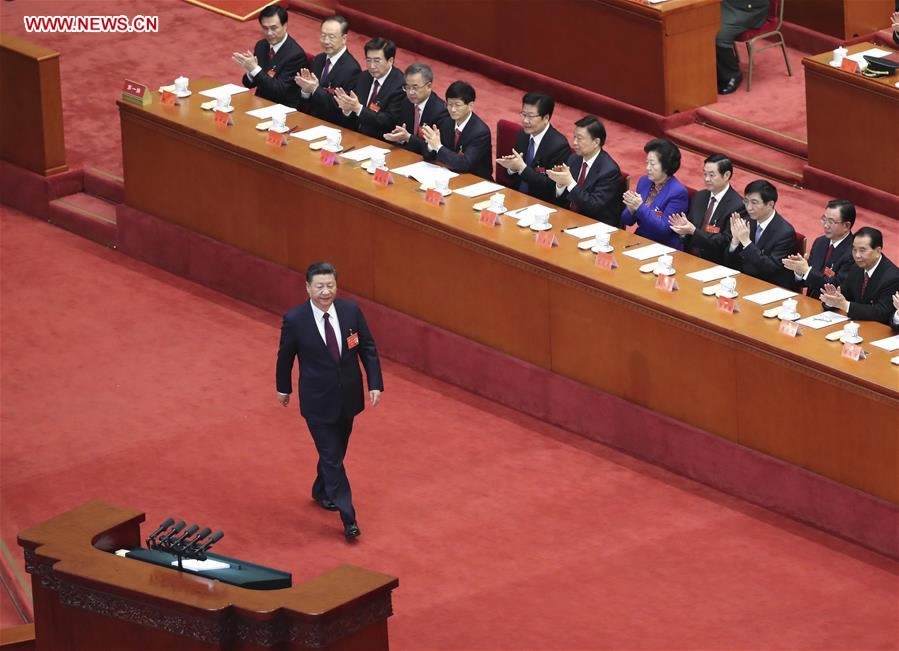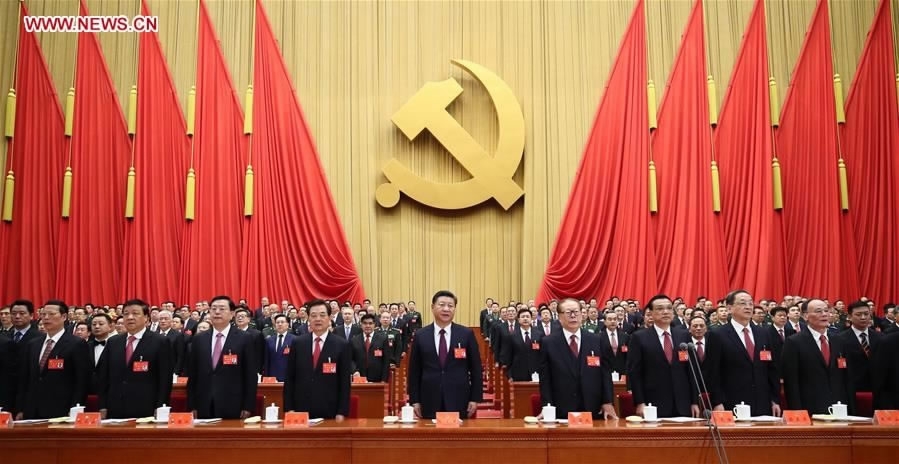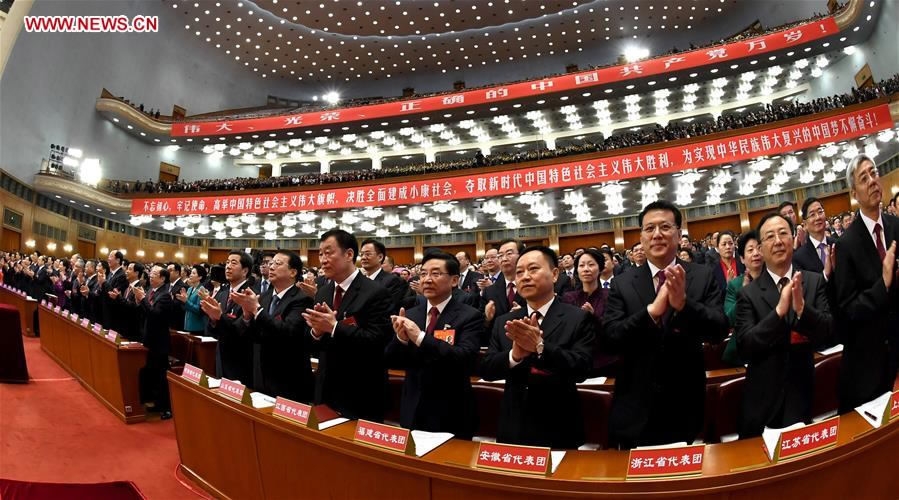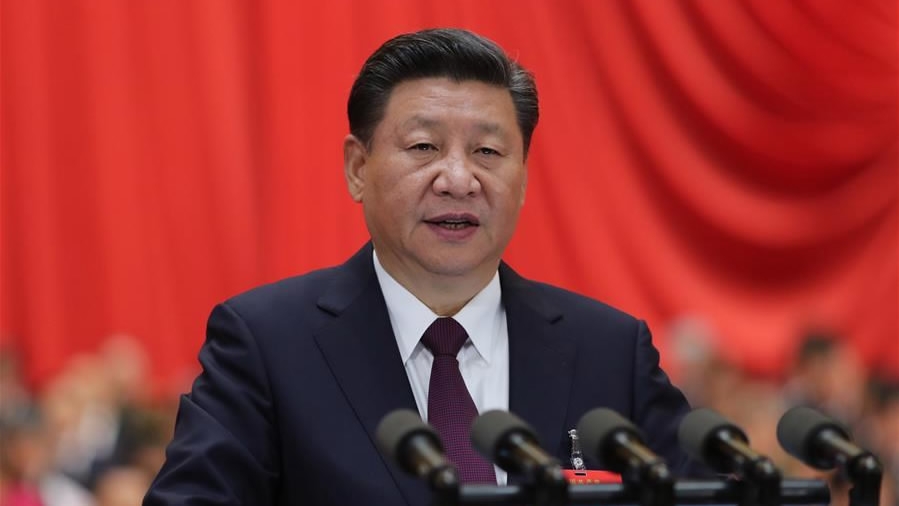Many Chinese were focused on their television screens on the morning of October 18th, 2017, as the General Secretary of the CPC Central Committee, Xi Jinping presented a three and a half hour speech spotlighting China on the world stage.
This was the first CPC Congress that emphasized China’s role in an integrated global context. Opening speeches at previous congresses had always focused on domestic issues, reform and opening, grappling with static state enterprises, or how to maintain hyper growth. Xi instead presented China as a global leader, sharing its own experiences in overcoming underdevelopment, re-balancing over-growth, correcting social imbalances and environmental damage by combining planning with market. And how the China Solution could offer a pathway, or at least an example, for other nations seeking their own pathways toward development.

Xi Jinping delivers a report to the 19th National Congress of the Communist Party of China (CPC) on behalf of the 18th Central Committee of the CPC at the Great Hall of the People in Beijing, China, Oct. 18, 2017. The CPC opened the 19th National Congress at the Great Hall of the People Wednesday morning. /Xinhua Photo
Xi Jinping delivers a report to the 19th National Congress of the Communist Party of China (CPC) on behalf of the 18th Central Committee of the CPC at the Great Hall of the People in Beijing, China, Oct. 18, 2017. The CPC opened the 19th National Congress at the Great Hall of the People Wednesday morning. /Xinhua Photo
Xi explained, “We have seen a further rise in China’s international influence, ability to inspire, and power to shape; and China has made great contributions to global peace and development.” He described China’s approach as “comprehensive, multilevel, multifaceted” using as examples the Belt and Road Initiative, Asian Infrastructure Investment Bank, Silk Road Fund, BRICS Summit among others. In 2016, the World Bank’s total aid to developing countries amounted to US$61 billion. In the same year China’s aid reached US$727.2 billion. Loans from China’s EXIM Bank alone exceeded the total provided by the World Bank.
Western models that talk democracy, transparency and governance often ignore the core issues that underdeveloped nations need to address in order to pull out from poverty into a trajectory of sustainable development. Without infrastructure, transport, communications, electricity, water and health care, people’s lives will not improve. China is not suggesting that any country should follow its economic model. But it is suggesting how infrastructure can offer a bandwidth for development.

Xi Jinping (C, front), Li Keqiang (3rd R, front), Zhang Dejiang (3rd L, front), Yu Zhengsheng (2nd R, front), Liu Yunshan (2nd L, front), Wang Qishan (1st R, front), Zhang Gaoli (1st L, front), Jiang Zemin (4th R, front) and Hu Jintao (4th L, front) attend the opening session of the 19th National Congress of the Communist Party of China at the Great Hall of the People in Beijing, capital of China, on October 18, 2017. /Xinhua Photo
Xi Jinping (C, front), Li Keqiang (3rd R, front), Zhang Dejiang (3rd L, front), Yu Zhengsheng (2nd R, front), Liu Yunshan (2nd L, front), Wang Qishan (1st R, front), Zhang Gaoli (1st L, front), Jiang Zemin (4th R, front) and Hu Jintao (4th L, front) attend the opening session of the 19th National Congress of the Communist Party of China at the Great Hall of the People in Beijing, capital of China, on October 18, 2017. /Xinhua Photo
In presenting the “China Solution” Xi is by no means promoting China as a single model to be followed. The global south has had enough cookie cutter models applied by certain western institutions and as espoused by their governments. Rather Xi is suggesting the China Solution as representing one nation’s own approach to its unique circumstances and challenges. The China Solution in essence emphasizes the need for local solutions by people themselves who understand their own culture and history, rather than external theories imported from institutions insensitive to local conditions and contexts.
The China Solution is not a model in itself, but rather about applying experiences. Solutions are based on local culture and local conditions. Everywhere in the world is different. However, China can share some of its experiences. The transformation of China from the 1980s-to present has involved massive fixed asset investment in infrastructure. Many of China’s provinces are land locked. Without roads, rails, and communication networks, and ports in the coastal regions, there would not have been the decades surge in foreign investment and exports. As much of the developing world faces similar challenges – land-locked states across Africa, Central Asia, and South Asia – the experience of China is relevant.

The Communist Party of China (CPC) opens the 19th National Congress at the Great Hall of the People in Beijing, China, Oct. 18, 2017. /Xinhua Photo
The Communist Party of China (CPC) opens the 19th National Congress at the Great Hall of the People in Beijing, China, Oct. 18, 2017. /Xinhua Photo
In many respects by coining the China Solution, Xi has set a tone for diversified localization rather than monolithic globalization. He has emphasized the need for respect of diverse systems based on each people’s heritage, rather than the cookie one model fits all approach that forced upon developing countries by certain western institutions. It is not based on a single model, but about being responsive to change, rather than reacting to crisis. External solutions that may have worked in Europe or America may not work in China or other developing countries.
Xi’s point is that the China Solution does not mean the solution came from China. It means the solution does not need to come from outside. Solutions for the developing world need to be bottom, while also requiring government guidance and infrastructure investment. The solution is with the culture, economy and psychology of each people and nation. That is the China Solution.
(Laurence Brahm is a founding director of the Himalayan Consensus Institute and a Senior Fellow with the Center for China and Globalization. He has lived and worked in China for 25 years and is the author of over 20 books on the Asian region. His work covers a wide spectrum from economic development reform in China and Southeast Asia to Tibetan new age travel. He is the author of Zhu Rongji and the Transformation of Modern China and China as No. 1. His books on Tibet include Searching for Shangri-la: Off the Beaten Track in Western China and Conversations with Sacred Mountains: A Journey along Yunnan's Tea Caravan Trail. The article reflects the author's opinion, and not necessarily the views of CGTN.)





